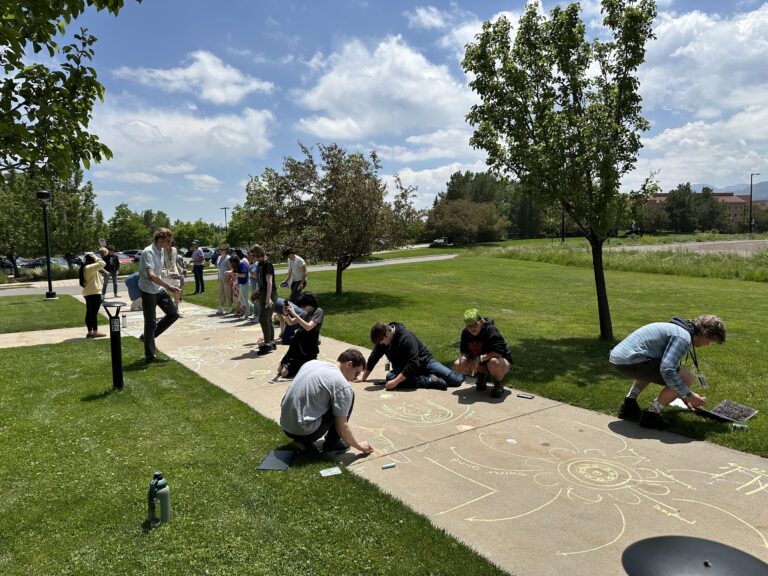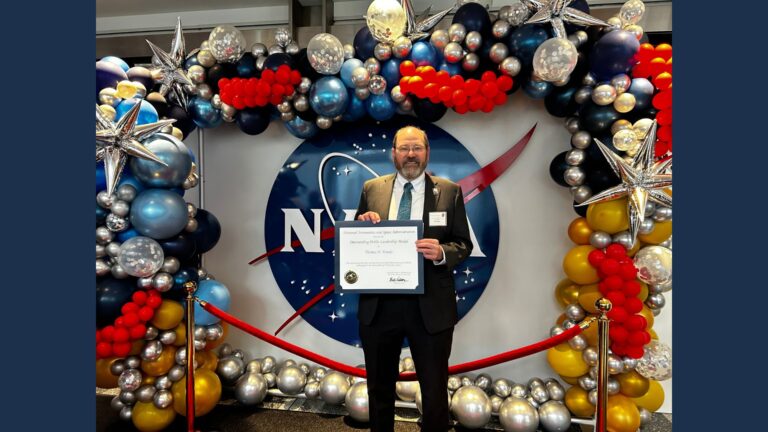On June 25, 2024, more than 50 LASP employees, family, and friends attended the Kennedy Space Center launch of NOAA’s GOES-U satellite carrying the fourth and final Extreme Ultraviolet and X-Ray Irradiance Sensors (EXIS) instrument aboard.
“Today, the final of our four EXIS flight models rocketed to space on GOES-U, soon to be GOES-19, to join its three siblings that are on GOES 16, 17, and 18,” said Frank Eparvier, associate director for science at LASP and lead scientist for EXIS. “It’s been a great pleasure and source of pride to have been part of such a wonderful team at LASP and to provide the best space weather instruments to NOAA and the world.”
The launch was a high point in the two-decade long EXIS program on which dozens of LASP employees worked, some for most, if not all, of their careers.
EXIS team members staffed an exhibit at Kennedy Space Center’s visitor center on the days surrounding the launch, where they displayed a model of the LASP-built EXIS instrument and engaged in discussions about LASP and EXIS with visitors of all ages, including young visitors who were particularly drawn to the model, as well as the stickers and pins.
Speaking to visitors at the booth the day before the launch was Project Manager Mike Anfinson, who has worked on the EXIS program since its inception in 2004 coordinating the building of all four instruments simultaneously. Anfinson says a big part of the success of the EXIS program was the “people continuity” that LASP was able to maintain by building all four of the instruments in parallel. This provided a significant cost savings and enabled LASP to deliver the instruments on time and on budget for which the team was recognized by the GOES-R program.
The EXIS instruments were built to be resilient and long-lasting, Anfinson said. Not only did they have to survive in the harsh environment of a geostationary orbit for 15 years or more, but they had to be in storage on the ground ahead of launch for many years.
The longevity of the instruments has been matched by the team that designed and built them. In recent years, despite nearing retirement, Anfinson has continued on at LASP part-time in order to see EXIS through its final launch, which was initially scheduled for Spring 2024, but delayed until June.
“It’s bittersweet, but I’ve had a good, very satisfying run because of EXIS,” said Anfinson, whose wife and some of their friends attended the launch with him. “It was nice to carry it all the way through to the last one.”
Anfinson and LASP engineering technician Wayne Baumann, who has worked on the EXIS program for 13 years, came to Florida early to prepare the instrument for launch and encapsulation in the fairing at the Astrotech facility at Kennedy Space Center.
“When I suited up for the last time at Astrotech, it really hit me,” said Baumann, whose family attended the launch the launch with him. “This is the milestone one.”
Andrew Jones, LASP instrument scientist for the extreme ultraviolet sensor (EUVS), has worked on the EXIS program since 2007 and attended two previous launches. “It’s a bit sad,” he said, of attending the final EXIS launch. “It’s been a big part of my life for a long time, but it’s exciting too.”
Jones’ sister Gwynneth came all the way from Scotland to see the final launch and support her brother’s work. “It’s been really cool to be here in person to support him and see what he has worked on for so long,” she said.
Resilient and vigilant: EXIS monitors space weather
The EXIS instruments measure light from the sun in multiple X-ray and ultraviolet wavelengths to monitor the different layers of the sun’s outer atmosphere. Each EXIS instrument has two sensors: the extreme ultraviolet sensor (EUVS) and the X-ray sensor (XRS).
EUV light from the sun has major impacts on the ionosphere. Increased EUV radiation can result in radio blackouts of terrestrial high-frequency communications. Increased EUV energy deposited in the Earth’s upper atmosphere (thermosphere) also results in increased atmospheric drag on satellites in low earth orbit. The EUV sensor provides improved measurements of these important wavelengths and information that assists operators of radio communication and navigation systems and satellites.
XRS measurements of X-ray emissions from the sun are relied on by NOAA’s Space Weather Prediction Center (SWPC) to issue warnings when there are large increases in solar X-ray output from solar flares. These X-ray flares cause changes in the ionosphere that can trigger radio blackouts of terrestrial high-frequency radio communications.
Elsayed Talaat, director of NOAA’s Office of Space Weather Observations, spoke in a joint NASA-NOAA science briefing on June 24 about the importance of space weather observations and the new compact coronagraph (CCOR) instrument joining EXIS and SUVI in the GOES-U solar-facing instrument suite. CCOR will be the nation’s first operational coronagraph in space, creating the equivalent of a total solar eclipse every 30 minutes, allowing continuous observations of the sun’s fainter outer atmosphere, the corona, where extreme space weather events originate.
“The coronograph working in tandem with a magnetometers, solar ultraviolet imagers and extreme ultraviolet and X-ray irradiance sensors aboard GOES-U will strengthen our ability to predict space weather,” Talaat said. “Because we are looking at the sun in the ultraviolet X-ray frequencies, which we can’t see from the ground, having such instruments in space allows us to see it 24/7.”
“It is vital that we be very vigilant in our space weather observations. To protect our economy, national security and individual safety, both here on Earth and in space. Although the sun is no more active than in previous generations, our society has changed and we are more sensitive than ever to the sun’s changing mood,” Talaat said. “NOAA satellites are the backbone of our country’s plan to become a Space Weather Ready Nation and we look forward to this extraordinary historical GOES-U launch getting us closer to the types of measurement we need on a continuous basis to be responsive and resilient to space weather events.”
While LASP is slated to continue to support the EXIS instruments until 2034, the lab is already looking ahead to the next generation of GOES satellites that will continue monitor weather both on Earth and in space, which are planned to begin launching in 2032.



